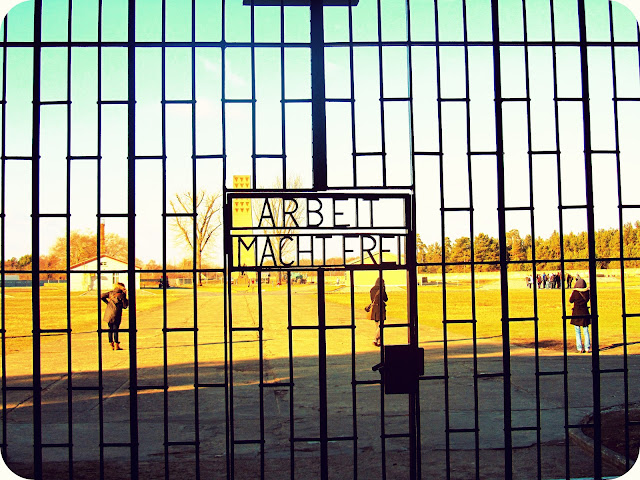Every one of us has heard about Auschwitz. The Swastika
immediately flashes to our minds, and we can’t even begin to imagine the grim
past that this infamous concentration camp in Poland has witnessed. However,
not many may have heard about one of the first of such concentration camps that
set up – the prototype, so to say. Sachsenhausen was the first new camp to be
set up after Reichfuhrer-SS Heinrich Himmler was appointed chief of German
Police in 1936.
Inmates of this concentration camp included Soviet prisoners
of wars, Jews, Jehovah’s witnesses, homosexuals, gypsies, artists, etc. Between
the period of 1936 to 1945, tens of thousands of these prisoners were brought
to Sachsenhausen of which over twelve thousand died. Sachsenhausen was not
built with the intent of making it an extermination camp. However, in 1943 a
gas chamber was constructed to kill large numbers of prisoners.
 |
| The infamous slogan on the entrance gate |
At the entrance you will see the sign “Arbeit Macht Frei”,
the slogan meaning “Labour makes (you) free". The camp was very well, a 9 ft stone wall was built, and
there was an inner perimeter of an electric fence. Dogs and the guards
themselves patrolled the space in between.
Prisoners were used for labor of all kinds. There is a gravel path where
the prisoners would have to test prototypes of shoes to be worn by the police
officers. These prisoners would carry extremely heavy loads on their backs and
walk this path. Sachsenhausen also played host to the largest counterfeit
operation ever. American and British currencies were counterfeited to large
extents in an effort to undermine those economies.
 |
| The paths where shoes were tested |
The camp memorial today has preserved a large number of
objects and documents retrieved from the site. In addition, some parts of the
barracks, which were destroyed, have been recreated to show the conditions in
which these inmates lived. A memorial was built for the Soviet Prisoners of war
with their famous “inverted red triangle” symbols painted on it. It is always a point of contention as to why
a memorial has been specially constructed only for this class of inmates, and
why not the rest. There is however a new
memorial built for all victims.
 |
| The memorial for Soviet prisoners of war victims |
 |
| A staff worker cleaning at the New Memorial |
An escape operation of humungous proportions was planned by
some of the prisoners at Sachsenhausen. Spearheaded by Bertram Arthur “Jimmy”
James, this was an operation that was carried out by digging a tunnel. James
participated in the “Great Escape” from Stalag Luft III. However, he was among
the 73 of 76 escapees who were caught. Of the 73 who were caught, Hitler asked
Himmler to execute more than half. James survived, and this was one of 12
failed escape attempts for him. Sachsenhausen was where he finally succeeded.
James’s “A Moonless
Night” describes the Sachsenhausen operation in amazing detail.
 |
| Dunkley tells us about Sachsenhausen |
How to get there – Sachsenhausen Concentration Camp Memorial is in
Oranienberg, Germany. We took a walking tour, and went with Nigel Dunkley from
Insider Tours, Berlin. The tour started off
at the Hackescher Markt S Station in Berlin, and then we headed off to the
Hauptbahnhof, the main station where we met a couple of other tourists who were
going with us. We took the train to Oranienberg, and a short bus ride later we were there.
Nigel Dunkley is a former British Military attaché
in Berlin, and he has very interesting anecdotes to narrate. The visit to the
memorial was more intriguing thanks to his fantastic narrative.
I learnt something today.
ReplyDeleteI wonder what bonds the residents of Sachsenhausen have with the city given it's sad past....